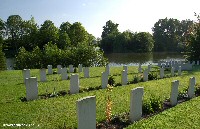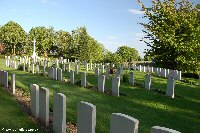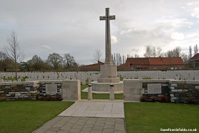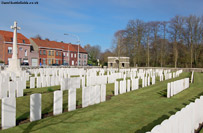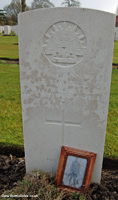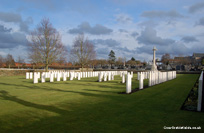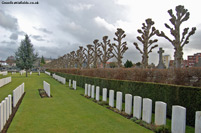Ypres Cemeteries
The World War One Battlefields site is undergoing a major update, with pages being converted to a new, user-friendly mobile format. The updated pages can be found at Updated World War One Battlefields. Some pages such as this one remain in the original format pending update.
This page covers the cemeteries found in Ypres itself and on its outskirts. Another page covers to other sites to be seen in Ypres.
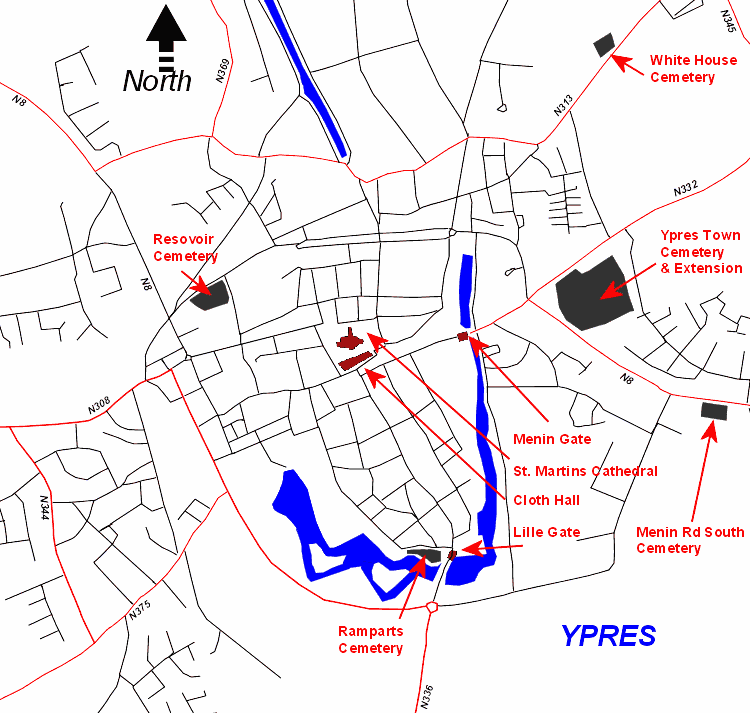
Map of Ypres
Most evocative and moving of the cemeteries to be found within Ypres is Ypres Ramparts Cemetery. As the name suggests, this small Cemetery (less than 200 graves) nestles by the ramparts of Ypres. It was started early in the War by the French, and then used from February 1915 to April 1918 by British and Commonwealth troops. All French graves were later removed. The cemetery can be seen in an early form on aerial photographs taken towards the end of the war. Today this is a beautiful and peaceful cemetery, with the graves positioned on a slope down towards the moat, and was a particular favourite of Rose Coombes (author of Before Endeavours Fade). I believe that after she died, her ashes were scattered here.
There is just one plot of graves, and a walk along the rows leads to some interesting observations. One section of row H comprises graves of men killed on the 9th of August 1915. They are from a number of units, including York & Lancasters, Royal Engineers, Royal Field Artillery and the Royal Army Medical Corps. As always, some of the personal inscriptions on the headstones cannot fail to make you reflect on the feelings of those left behind. In row J, the inscription on Lance-Corporal Arthur Ockelford's grave reads 'Gone but not forgotten from his loving wife and baby Peggy' - Peggy who must have grown up never knowing her father. On Private Albert Pacey's headstone are the words 'Some may think that we forget him when at times we are apt to smile'. Albert Pacey from Peterborough was just 22 when he died on the 4th of February 1915 serving with the 2nd East Yorkshires.
Also buried in this cemetery is Captain William Megaw of the 1st Norfolks, who died on the 31st of March 1915. There is a brass plaque commemorating him in St. Georges Memorial Church not far from here. The inscription on his headstone gives both his rank and his title of Adjutant. There are a number of graves of New Zealanders at the front left, and Australian graves at the back left of the cemetery. As well as the different nationalities, men from at least two Divisional Heaquarters are also buried here. The cemetery is beautiful on a sunny day, and when it rains the white backs of the headstones turn dark at the edges as the water seeps through as though through parchment or blotting paper.
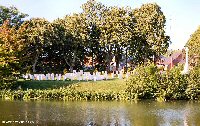
Ramparts Cemetery seen from across the moat
The largest cemetery within the town is Ypres Reservoir Cemetery. This is in the north-west of the town, and was located next to an Advanced Dressing Station where many casualties who had survived as far as this following transfer from the front lines were buried. There were originally three cemeteries near the town's western gate, two between the prison and the reservoir, and these two were both concentrated into the third, which is located on the north side of what was the prison (hence an earlier name for this cemetery, Ypres Prison Cemetery - it was also previously known as Ypres Reservoir North Cemetery).
The cemetery was begun in October 1915, and used from then on throughout the war, and contained around 1100 graves after the Armistice. It now contains 2613 graves, over 1000 of which are unidentified. The register gives the interesting information that the graves of the men in Plot 5 Row AA are those of 16 soldiers from the 6th Duke of Cornwall's Light Infantry who were killed on the 12th of August 1915. They were billeted in the vaults of the cathedral (see above) and killed by shelling from what was known as the "Ypres Express", a large calibre German gun firing from the Houthulst Forest. The bodies were not recovered until after the Armistice.
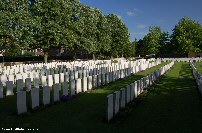
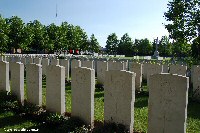
Ypres Reservoir Cemetery - the right hand picture shows on the front right the headstones of the Knott brothers
Two men buried here are the Knott brothers - Captain Henry Basil Knott of the 9th Battalion Northumberland Fusiliers (died 7th of September 1915), and Major James Leadbitter Knott of the 10th West Yorkshire Regiment. James Knott was killed on the first day of the Battle of the Somme, on July the 1st 1916 near Fricourt some 70 miles south of Ypres. He was originally buried where he died, in Fricourt New Military Cemetery (see the Fricourt page). However, after the war his body was moved to lie here next to his brother. This was a most unusual event, and it is possible to speculate that the influence and importance of the brothers father, Sir James Knott, had something to do with this. Sir James Knott donated the money to construct the tower at St. Georges Memorial Church in Ypres. He also built a church at Fenham in Newcastle named St. James & St. Basil's Church in memory of his sons.
However, the file on Henry Knott held at the National Archives in Kew shows that he was not originally buried in this cemetery either. The 9th Nothumberland Fusiliers War Diary entry for the 6th of September records that Henry Knott was wounded in 'Western Redoubt, Bois Carre' and was taken by ambulance to Poperinghe, where he died at 1.40 a.m. the next morning. Bois Carre was a small wood located noth-east of Vierstraat (south-west of Ypres), and Western Redoubt was a fortified position just inside its western edge. In November 1915 his father was sent a letter stating that Henry Knott was buried in the 'New Cemetery near Poperinghe'. Poperinghe is located about seven miles west of Ypres, and whilst there is a Poperinghe New Military Cemetery today, the map reference given (Sheet 27 Square L 22d.6.3) is either in or very near to where the large cemetery at Lijssenthoek is now located. As he died at Number 10 Casualty Clearing Station (which was located near Lijssenthoek) of gun shot wounds to the head, this would make more sense than his being originally buried in Ypres itself. It seems therefore that Henry's body must have been moved to Reservoir Cemetery in Ypres, and that his brother was then moved from the Somme to lie beside him, almost certainly at the same time.
In 1919, his father Sir James Knott annotated a form sent by the War Office enquiring about his sons next of kin with the words "He was my third son and unmarried. On the outbreak of war my family consisted of three sons. I had no daughters, all three [sons] joined up in August 1914."
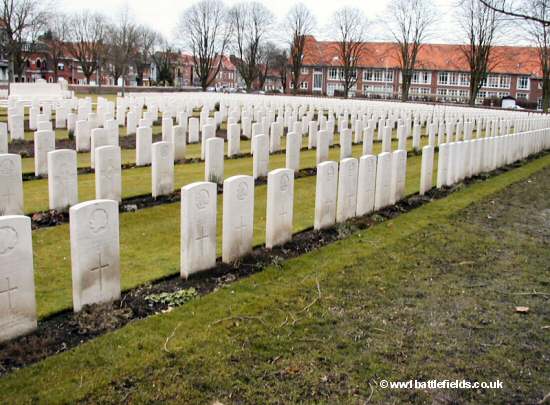
Ypres Reservoir Cemetery today
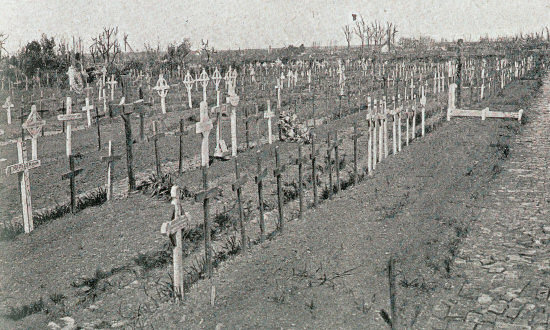
Reservoir Cemetery just after the War. Photo from the Michelin Guide to Ypres
On the outskirts of Ypres are three more cemeteries, now also within the town itself although not within the ramparts. The largest is Ypres Menin Road South Cemetery, located on the busy N8 as you leave Ypres towards Hellfire Corner.
The cemetery was first used in January 1916, by the 8th South Staffordshires and 9th East Surreys. It was in use until the summer of 1918. Following the Armistice, graves were concentrated here from Menin Road North Cemetery, as well as from isolated positions on the battlefields around, and there are special memorials to 54 men who were buried in Menin Road North Cemetery, but whose graves were probably destroyed later by shell-fire, and could not be located.
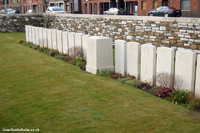
The special memorials at Menin Road South Cemetery
These special memorials are located on either side of the entrance. The Cemetery layout at first sight appears quite regular, which is more usual in post-war concentration cemeteries; but the somewhat uneven layout of many of the graves denotes it's contemporary nature. A single grave can be seen by itself near the front: Sergeant W Brook of the Royal Artillery, who died on the 10th of November 1914. One wonders what the story is behind this grave, as it appears to pre-date the start date of the cemetery and was presumably moved here later. There is also one grave by itself near the back - that of Captain W Reid of the RAMC who died in October 1917.
The grave of an Australian soldier had a small framed photograph placed next to it the last time I visited. This was the grave of Gunner Edward MacGill, from Victoria, who was a 26 year old farmer when he enlisted in 1916. His journey from Melbourne to Plymouth on board the Aeneas in late 1916 took six weeks, and after training at Larkhill near Salisbury he was posted to France in April 1917. He was killed in action on the 20th of September 1917. Although the photograph next to the grave is of course black and white, MacGill's service record shows that he was fresh complexioned, with blue eyes and brown hair.
The second cemetery on the outskirts of Ypres is Ypres Town Cemetery and Extension. This is located by the N332 road that leads to Zonnebeke, about half a mile north-east of the Menin Gate. Technically there are two War cemeteries, and they are listed separately on the CWGC website (although the cemetery reports seem to overlap). The Town Cemetery is still in use as a civilian graveyard today, and the war graves are found in several areas within it. In addition to the graves of those who fell during the war, several workers from the IWGC (as it was previously) and CWGC are also buried in this cemetery.
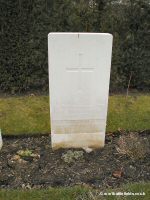
IWGC grave at Ypres Town Cemetery
The Ypres Town Military Cemetery is a few rows of graves amidst the civilian graves. The Extension is set within the middle of the civilian cemetery, reached either through it from the N8 or along a small track from the N332 which leads to Zonnebeke. During the war, the civilain cemetery that already existed here was marked on trench maps, but consisted then only of the section to the right of the Extension - that is, nearer to Ypres town centre. One famous man buried here is Lieutenant Lord Worsley of the Royal Horse Guards, who died at Zandvoorde (and this place name is inscribed on his headstone). The Household Cavalry Memorial at Zandvoorde is located on the site of his original burial site.
Travelling north out of Ypres on the N369, Duhallow ADS Cemetery is located on the right-hand side of the road on the outskirts of the city. In 1918 there were numerous temporary buildings erected around about, namd DuHallow Camp, and this was the site of a Main Dressing Station (located just to the south of the cemetery). This is an interesting cemetery, as it is from here that the large stone blocks seen in many CWGC cemeteries in front of special memorial headstones (to commemorate men who are known or believed to be buried in a cemertey, but the location of whose graves is not known) take their name. They are known as 'Duhallow blocks', and were first used here. There are two of these blocks here - on the left side of the cemetery one in front of a semi-circle of special memorials to men who were buried in Fusilier Wood Cemetery, and on the right side in front of a row of special memorials commemorating men who were buried in Malakof Farm Cemetery.
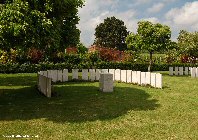
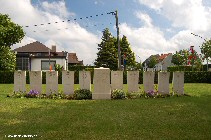
'Duhallow blocks' - which take their name from first use in this cemetery - commemorating men originally buried in Fusilier Wood and Malakof Farm Cemeteries
The cemetery was an original wartime one, used from July 1917 through till November 1918, and in 1918 was used by a number of Casualty Clearing Stations. It was however enlarged after the Armistice. I have a picture of this cemetery taken probably early in the 1920s, and this is shown below. It was probably taken from the spot where a house now stands to the left of the cemetery. A second view, perhaps from the 1930s shows that the level of the road has changed since then, as the gates are now lower.
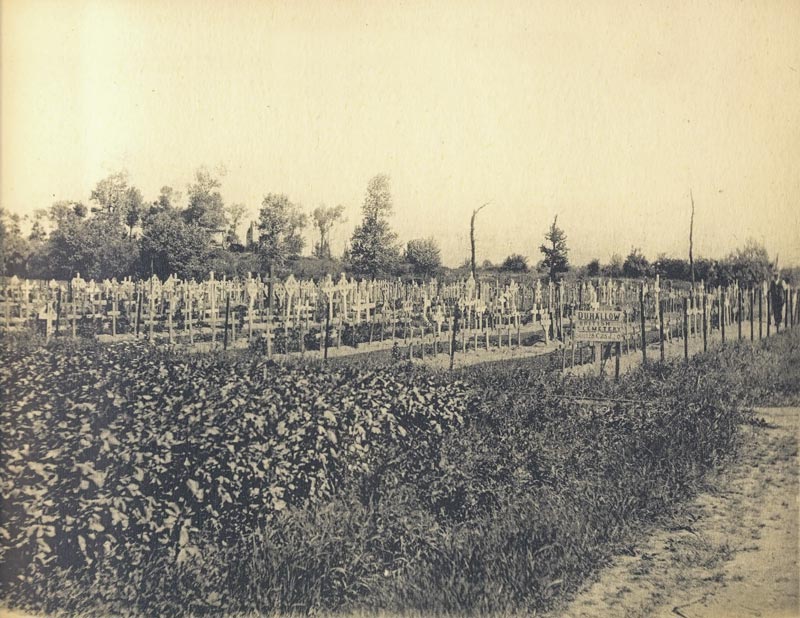
Duhallow Cemetery shortly after the War
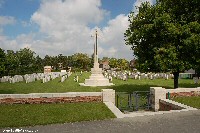
Entrance to Duhallow ADS Cemetery today
In Plot 2 row F is what looks like a mass grave, of men whose headstones mainly show the Seaforth Highlanders insignia. The headstones touch each other and some stones have two names on. However, the details for these men show that they were in fact part of the Labour Corps, and the register states that 41 men from the 13th Company Labour Corps were killed when a German aircraft bombed an ammunition truck on the 9th of January 1918. Next to this is a row of German graves, and in the cemetery there are also a few French graves and one Belgian grave.
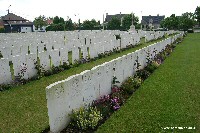
Duhallow ADS Cemetery - in the foreground a row of headstones touching, a mass grave of men of the Labour Corps killed January 1918
Sources & Acknowledgements
Commonwealth War Graves Commission website
Major & Mrs. Holt: Battlefield Guide to the Ypres Salient
Paul Reed: 'Walking the Salient' and other information

